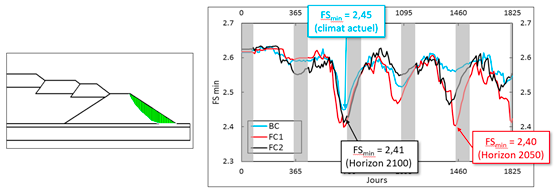Integration of climate change into the design and reclamation of tailings storage facilities
This study responds to a need expressed by mining companies and the provincial government to review mining waste management measures by considering climate change and its impacts on the industry in order to ensure the long-term sustainability and safety of tailings structures.
Project details
Principal(s) investigator(s)

Context
Given its many interactions with the surrounding natural environment, Québec’s mining sector is vulnerable to climate change, particularly in relation to tailings storage facilities and mine site reclamation. As such, social acceptability and long term performance of mining projects will be influenced by the ability of mine managers to adapt their infrastructures to the impacts of climate change.
While the mining industry has historically been more concentrated in southern Québec, the impact of climate change in this region has not yet been rigorously studied compared with the efforts made in the north of Québec. Therefore, it is crucial to examine the issue and propose approaches suited to these regions which will enable managers to integrate climate change right from the structure design phase.
Photo : Gwendoline Hotton
Objective(s)
-
Develop a methodical approach aimed at integrating climate change from the design phase of works for the storage and reclamation of mine tailings.
Methodology
-
Identify and quantify extreme weather conditions in relation to the design of tailings storage and reclamation works.
-
Assess the change in the performance of storage structures in the face of climate change in order to gain a better understanding of different reclamation methods.
-
Estimate the influence of climate change on the design of tailings storage structures by estimating the volumes of water to be managed. Two case studies representing distinct sets of conditions will be conducted: the Canadian Malartic open-pit mine and the Doyon-Westwood underground mine.
-
Develop a methodological approach integrating climate change in the design and reclamation of tailings storage facilities.
Results
In Abitibi-Témiscamingue, water management structures are vulnerable to heavy accumulations of rain, with risks of overtopping, erosion and rupture. Two studies were devoted to these structures: one on drainage ditches and one on a mine tailings dam. The probable maximum precipitation (PMP) was identified as a climate index of interest for these two studies because it is used for the design of this type of structure.
The performance of reclamation methods applied to mine sites upon closure may also be affected by climate change. The two reclamation methods studied in this project are oxygen barriers: a cover with capillary barrier effect (CCBE) on an abandoned site that was reclaimed beginning in 1999, and a monolayer cover with an elevated water table on an active site. These covers are particularly sensitive to the desaturation of the water-retaining layer and of the tailings, respectively. A drought index was developed and defined as a climate index of interest for these two studies. For all the cases studied, the same approach was applied.
Each structure of interest was reproduced as a digital model. This model was calibrated using measured data (characteristics of materials, piezometric levels, meteorological data, etc.). Climate scenarios were used as boundary conditions in the numerical model to assess the performance of the structures in a future climate. Subsequently, the past and future characteristics of the climate index of interest were entered into the numerical model to assess the behaviour of the system under current and future extreme conditions.
The drainage ditches did not show a potential long-term failure in the numerical simulations with the various climate scenarios or with the past and future PMP values considered. The safety factor of the dam studied did not fall below 1 in the simulations, leading to the conclusion that the structure has good resilience to climate change (Figure 1).

Figure 1 : Évolution du facteur de sécurité (FS) de la berme de départ (indiquée en vert sur le schéma de gauche) sur une période de 5 années pour différents horizons (climat actuel (BC) : bleu ; horizon 2050 (FC1) : rouge ; horizon 2100 (FC2) : noir) pour le scénario RCP8.5. Les hivers sont indiqués en gris. Tiré de Gandonou (2018).
The climate scenarios considered as well as the drought index in past and future climates did not demonstrate a negative effect on the long-term performance of the CCBE studied. Analysis of the reclamation method with a monolayer cover and elevated water table for various configurations showed that climate change could reduce its effectiveness in the long term.
This project made it possible to develop a methodological approach aimed at integrating climate change as early as the design phase of structures for the storage and reclamation of mining waste. It was tested and validated by means of four case studies on different types of structures.
Benefits for adaptation
Benefits for adaptation
This study responds to a need expressed by mining companies and the provincial government to review mining waste management measures by considering climate change and its impacts on the industry in order to ensure the long-term sustainability and safety of tailings structures.
The benefits for adaptation lie both in the assessment of corrective work on mine tailings management structures under government responsibility and in the development of new approaches (i.e., numerical, decisional) that will enable mining companies to take climate change into consideration right from the structure design phase.
Scientific publications
Funding

Other participants
-
Polytechnique-Montréal,
-
Mine Canadian Malartic,
-
IAMGOLD